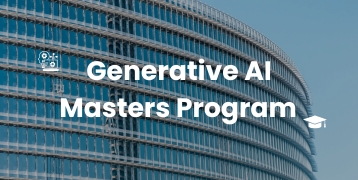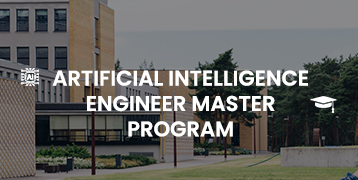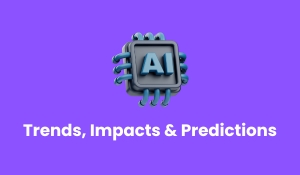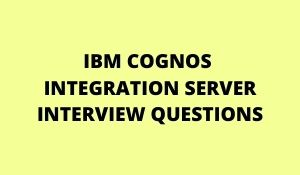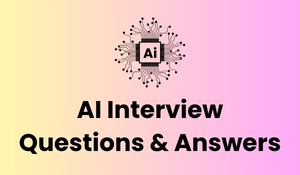
Artificial Intelligence (AI):
The technique through which a computer system reflects human intelligence is known as artificial intelligence (AI). Learning the process of obtaining knowledge and the rules for applying it reasoning the capacity to solve problems and make decisions and corrections are all examples of process testing. Machine learning, natural language processing, robotics, and computer vision are subsets of artificial intelligence (AI) that focus on enabling computers to perform tasks that require human intelligence like Individuals.
Artificial Intelligence is divided into two primary categories: are
Narrow AI:
Narrow AI, also known as weak artificial intelligence, is the main focus of most AI applications today, mainly used for tasks such as chess, facial recognition, and language translation.
General AI:
General AI, or strong AI, sometimes referred to as AGI, aims to understand, acquire, and use intelligence on a level comparable to human mental abilities, although this milestone has not yet been achieved.
Nowadays technology develops very fast so we can gain Knowledge is Very important in AI(Artificial Intelligence) tools. We strongly believe that these questions are very useful for your career growth. Take the next step in your journey with the GoLogica Most Frequently Asked Artificial Intelligence Interview Questions in 2024.
Here GoLogica Can Provide the Top 50 frequently asked AI interview questions. These questions are used for both Freshers and experienced professionals in 2025:
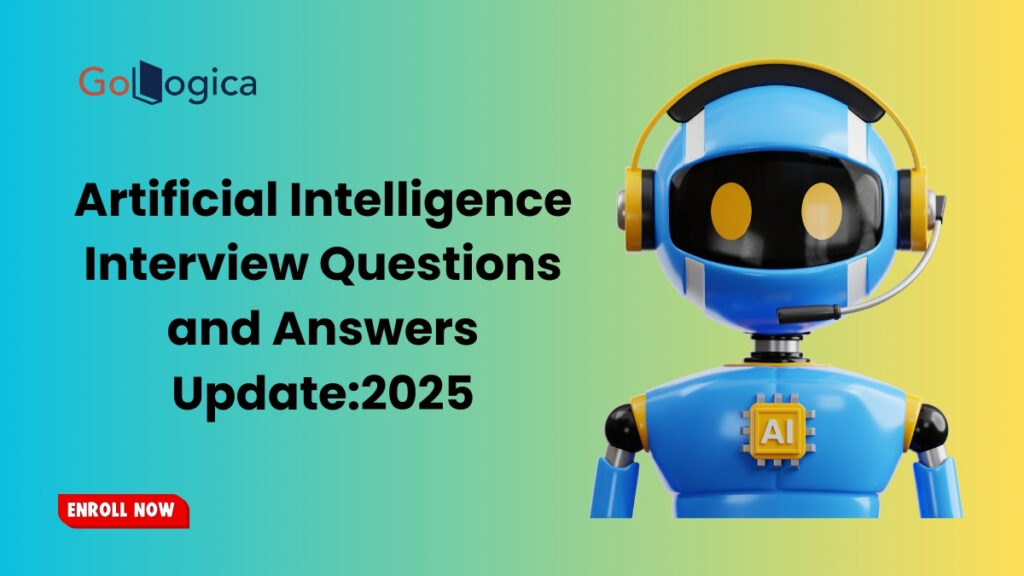
What is artificial intelligence?
It is a technology under computer science that creates intelligent programs for executing operations that normally involve human thinking, such as language comprehension and problem-solving
How does AI differ from traditional programming?
Traditional programming is static, relying on the subject of explicit instructions and belief logic, even if AI is adaptive, probabilistic, and talented at learning from data and patterns.
What are the main types of AI?
AI is separated into Two types:
Narrow AI (ANI) for specialized tasks
General AI (AGI), is for human decision-making capabilities and can learn from data in many fields.
What are the most common applications of AI in unexceptional computer graphics?
AI has transformed a broad range of industries by offering a greater-than-before enthusiast experience, personalization of content, and detection such as virtual assistants, search engines, and social media.
How is AI used in healthcare?
AI has enhanced healthcare through diagnosis and treatment upgrades as skillfully as increased helpful outcomes through:
- Broadminded image analysis
- Drug discovery
- Personalized medicine
- Remote cooperative monitoring, and automation.
How Does AI Benefit Finance and Banking?
- Automating, making modernizing decisions
- Detecting fraud
- Customer-centric sustainability.
What Is the Role of AI in the Development of Self-Driving Cars?
AI software, Computer vision
Sensor union
Robot learning
Passage planning is used to manufacture a self-driving car.
How is AI used in NLP?
AI has invented NLP as a way for computers to understand and produce human language and improves the applications in machine translation, sentiment analysis, information retrieval, and related applications.
How do organizations apply AI in automating business processes?
Artificial intelligence nowadays changes businesses by technology of business processes and helps increase productivity, reduce costs, improve decision-making, allow access to a competitive advantage, and preserve customer satisfaction.
How is AI used in cybersecurity?
AI enhances cybersecurity by spotting and eliminating threats with data analysis, threat prediction, incident response, fraud detection, and network optimization security.
Related Courses
| Course Name | Enroll Now |
|---|---|
| Artificial Intelligence Engineer Masters Program | Enroll Now |
| Deep Learning with TensorFlow Training | Enroll Now |
| Machine Learning Masters Program | Enroll Now |
| AI and Machine Learning in Finance Training | Enroll Now |
| Applied Data Science with Python Training | Enroll Now |
How does AI affect education?
- AI transforms education by developing customized learning experiences
- Automating administrative work
- Improving student performance
- Studying student data
- Developing smart intelligent tutoring systems for education, making it accessible to disabled students.
What are some different types of AI?
There are two types of AI:
- Narrow AI (ANI) or task-specific AI
- Advanced AI (AGI), can track human decision-making abilities, and learn just as well from misleading information.
What is the connection between Machine Learning (ML) and Artificial Intelligence (AI)?
Machine learning (ML) is the subset of AI, meant to use alternating algorithms in improving actions and responding to complicated tasks for improved solving authentic-world problems that AI might come across.
How does supervised learning differ from unsupervised learning?
Supervised and unsupervised learning are those subsets of machine learning that have been trained upon labeled and unlabeled datasets, respectively, for predicting or classifying late gathering data by private school patterns.
What are neural networks in AI?
- Neural networks, machine learning algorithms inspired by the human brain, are utilized in various fields such as:
- Image recognition
- Natural language processing
- Speech recognition
- Recommendation systems, and medical diagnosis.
What is deep learning?
- Deep learning, which is a subset of machine learning, processes complex information through artificial neural networks.
- Similar to the human brain and is used in image recognition
- Natural language processing
- Speech recognition, and medical research.
What is a neural network’s activation function used for?
- Activation functions in neural networks, like:
- Sigmoid
- ReLU
- Tanh, and Leaky ReLU
These can be used to learn complex and optimize for specific tasks.
What is overfitting, and how can it be prevented?
Overfitting in machine learning occurs when functions become too complex, ignoring patterns.
It can be prevented by using regularization, cross-validation, and increasing training data.

What is a dataset in machine learning?
A machine learning dataset is a collection of data used for understanding concepts, and issues.
How does the training process differ from the testing process?
- The machine learning data sets are divided into training sets and test sets.
- These algorithms are used to quantify the efficiency of unobserved data, prevent overfitting, assess generalizability, and compare models.
What is the external width of Backpropagation?
Backpropagation is a deep learning program that addresses a fundamental aspect of the importance of neurons.
What is reinforcement learning?
Reinforcement learning is a robotic learning approach based on different tasks such as sports games, robotics, autonomous driving, and personalized recommendations
Are you able to become used to natural language processing (NLP)?
Natural Language Processing (NLP) is a sophisticated method that utilizes human language for various applications, overcoming challenges such as obscurity and data scarcity.
What is a decision tree in robot learning?
Decision Tree is a robot learning algorithm used for classification and regression tasks.
What are common applications of AI that you have come across?
AI plays a crucial role in various industries, personalizing recommendations, and detecting stuff news, connected to difficult applications.
What is the significance of data preprocessing?
Data preprocessing can involve transforming, and organizing raw data for analysis, improving data quality, and identifying errors.
What is a confusion matrix, and what does it comport yourself?
A confusion matrix is a machine learning visualization tool that compares a model’s predictions to unqualified labels, providing insights into accuracy, recall, and Further clarification.
What is the difference between classification and regression?
Classification and regression are supervised machine learning tasks:
Both are statistical methods used to predict continuous numerical values by assigning data points to predefined categories.
Why is ethics important in AI development?
Ethics in AI development is crucial for creation, privacy, transparency, safety, and social impact.

How can AI help with this personalized collective experience?
AI enhances marketing by analyzing and creating detailed customer profiles, emails, and product recommendations, thereby improving customer satisfaction and brand support.
What is robot learning, and how is it complex to AI?
Machine learning, a subset of AI, develops algorithms for data analysis, decision-making, and automation using supervised, unsupervised, and reinforcement learning techniques for more adaptive technologies.
What are the key challenges you’ve faced when deploying AI models in production?
AI model deployment in production faces challenges like:
- Data drift
- Interpretation
- Scalability, and ethical considerations
- Necessitate careful planning
- Collaboration
- Transparency.
How do you ensure scalability and performance optimization in AI systems?
- Strategies like hardware
- Algorithms
- Data
- Software
- Architecture and continuous monitoring are employed to optimize AI systems for scalability and performance in large-scale applications.
What techniques get your hands on you use to handle imbalanced datasets?
Oversampling, undersampling, class weighting, ensemble methods, data strengthening, algorithm selection, and cost-sore spot learning are techniques for addressing imbalanced datasets.
How do you address the concept of definition and interpretation of models in AI?
AI concepts such as translation and interpretation are important in critical areas such as healthcare, finance, criminal justice, and transparency.
How do you go about hyperparameter tuning for fuzzy models?
Hyperparameter tuning is an important step in the robotic learning model definition, which includes grid search, random search, evolutionary algorithm, gradient-based optimization, automatic tuning, and hierarchical tuning.
What is your strategy for avoiding over-fitting deep learning models?
Overfitting in deep learning models is caused by excessive risk, and the methods used to deal with it include regularization, data enhancement, dropout, transfer learning, over-parameter tuning, simpler models, and so on.
Can you pass on your experience with Generative Adversarial Networks (GANs) soon?
The research investigates the use of generative adversarial networks (GANs) and their application in image generation. It deals with training instability and recognizes special orders.
How did you apply reinforcement learning to a business project?
The project used reinforcement learning to improve supply chain efficiencies, aggressively adjust inventory based on demand, reduce costs, and prevent outages.
What is your plan for feature engineering and how do you make sure it works?
Processes include improving user understanding, analyzing data types, modifying changes, adding features, and implementing critical strategies to improve efficiency and predicted results
What steps are you taking to ensure your AI model isn’t biased?
Ensuring that AI models are unbiased is critical for unbiased ethical outcomes. Here are the steps I take:
- Diverse Data Collection
- Bias Assessment
- Preprocessing Techniques
- Model Interpretability
- Continuous Monitoring
- Stakeholder Engagement
How do you approach real-time inference in AI systems?
Real-time inference in AI systems is achieved by selecting and implementing efficient data pipelines. This is done using frameworks such as TensorFlow Serving or ONNX, and monitoring the system’s performance.
What is your experience with edge AI, and how have you implemented it?
Edge AI, real-time machine learning models, and optimized data processing in industrial automation applications are used for image classification and model retraining.
How do you integrate AI systems with cloud platforms like AWS, Azure, or Google Cloud?
- Cloud Service Selection
- Data Storage
- Model Development
- API Integration
- Monitoring and Maintenance
- Security
What methods do you use for anomaly detection in large datasets?
- Statistical Methods
- Machine Learning Techniques
- Data Visualization
- Domain Knowledge
Can you think of a scenario where interpretable AI (XAI) was critical to the business?
Interpretable AI (XAI) was used in the credit risk assessment project to ensure compliance, build stakeholder confidence, and improve model performance.
How do you handle missing or noisy data in AI model development?
Handling missing or noisy data is crucial for developing robust AI models. Here’s how I approach these challenges:
- Understanding the Nature of Missingness
- Imputation Techniques
- Using Algorithms That Handle Missing Data
- Validation and Cross-Validation
- Robust Algorithms
What’s your approach to model retraining and maintenance in production environments?
- Monitoring Model Performance
- Data Drift Detection
- Statistical Tests
- Automated Pipelines
- Documentation and Communication
Can you provide examples of how you’ve used AI for business process optimization?
Certainly! Here are a few examples of how I’ve used AI for business process optimization across different industries:
- Predictive Maintenance in Manufacturing
- Customer Segmentation in Retail
- Supply Chain Optimization
- Fraud Detection in Finance
- Automated Document Processing

Conclusion:
AI is one of the most in-demand career opportunities during 2025, said with deep technical and practical understanding. Many questions raised in interviews include algorithms, deep learning, NLP, and how not to misuse AI with harmful practices.
They need to be aware of the key concepts and algorithms, programming skills, data preparation, deep learning, ethical considerations, and problem-solving. The basic algorithms known by the candidate include decision trees, support vector machines, and clustering methods.
Also, they need to be aware of deep models consisting of convolutional neural networks and recurrent neural networks. Skilled knowledge of programming languages and libraries is also very important.
Candidates must demonstrate how to implement machine learning algorithms from scratch, the ability to use tools like Jupyter Notebooks or IDE and Git, and at least some experience with real-world datasets for demonstrating data handling skills. Ethics in AI and interpretability are also important aspects as candidates should be able to discuss ethical implications and explain decision-making processes to non-technical stakeholders. Strong communication, critical thinking, and a collaborative attitude help ace AI interviews.
To excel in the Most frequently asked artificial intelligence interview questions in 2025, candidates must have a thorough understanding of technical concepts, hands-on experience, ethical considerations, coding skills, and communication capabilities. Enroll in GoLogica for a bright future.
👉 Related Articles:
🎯 Artificial Intelligence: A Complete Overview of Its Pros and Cons
🎯 Top 15 Artificial Intelligence (AI) Tools You Need to Know
🎯 Automation Anywhere Interview Questions and Answers
🎯 What is TensorFlow? Learn Here
🎯 Artificial Intelligence – An Introductory Guide
🎯 AI and Deep Learning Tutorial: Everything you need to know
🎯 Artificial Intelligence Interview Questions and Answers Update:2025
🎯 AI Engineer Salaries in 2025

